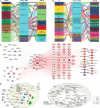Multiomics global landscape of stemness-related gene clusters in adipose-derived mesenchymal stem cells
- PMID: 32698873
- PMCID: PMC7374825
- DOI: 10.1186/s13287-020-01823-3
Multiomics global landscape of stemness-related gene clusters in adipose-derived mesenchymal stem cells
Abstract
Background: Adipose-derived mesenchymal stem cells (AD-MSCs) are a type of stem cell that is abundant and widely used. The molecular characteristics of AD-MSCs from different passages from donors of different ages have not been well elucidated.
Methods: Six kinds of AD-MSCs ((E1, E2, E3, Y1, Y2, and Y3) with E denoting cells derived from an elderly patient, Y denoting cells derived from a young patient, and 1, 2, and 3 representing passages 3, 6, and 10) were obtained from human abdominal adipose tissue. We obtained the protein expression profile, the mRNA expression profile, the lncRNA expression profile, and the methylation profile of each kind of AD-MSC by sequencing. After calculating the stemness indices, genes related to stemness were extracted. The multiomics correlation analysis was performed in the stemness-related genes. In addition, short time-series expression miner (STEM) analysis was performed for all cell passages and donor ages. To further explore the biological functions of the stemness-related genes, we performed Gene Ontology (GO) and Kyoto Encyclopedia of Genes and Genomes (KEGG) enrichment analyses. Finally, the lncRNA-KEGG network and transcription factor (TF)-KEGG network were constructed based on the RNAInter database and TRRUST v2 database.
Results: The stemness of the Y1, E1, and Y2 cells was higher than that of the E2, Y3, and E3 cells. The stemness was the highest for Y1 cells and the lowest for E3 cells. STEM analysis showed that five stemness-related gene clusters were associated with the cell passages, and only one gene cluster was associated with age. The enrichment analysis results showed that the biological processes (BPs) and KEGG pathways were mainly involved in the proliferation, differentiation, and migration of cells. The global regulatory landscape of AD-MSCs was constructed: 25 TFs and 16 lncRNAs regulated 21 KEGG pathways through 27 mRNAs. Furthermore, we obtained a core stemness-related gene set consisting of ITGAV, MAD2L1, and PCNA. These genes were expressed at higher levels in Y1 cells than in E3 cells.
Conclusion: The multiomics global landscape of stemness-related gene clusters was determined for AD-MSCs, which may be helpful for selecting AD-MSCs with increased stemness.
Keywords: AD-MSCs; Adipose-derived mesenchymal stem cells; Multiomics global landscape; Short time-series miner analysis; Stemness gene clusters.
Conflict of interest statement
The authors declare that they have no competing interests.
Figures






References
-
- Gentile P, Kothari A, Casella D, et al. Fat graft enhanced with adipose-derived stem cells in aesthetic breast augmentation: clinical, histological, and instrumental evaluation. Aesthet Surg J. 2019.sjz292. - PubMed
-
- Gentile P, Scioli MG, Bielli A, et al. Comparing different nanofat procedures on scars: role of the stromal vascular fraction and its clinical implications. Regen Med. 2017;12(8):939–952. - PubMed
Publication types
MeSH terms
Substances
LinkOut - more resources
Full Text Sources
Research Materials
Miscellaneous

